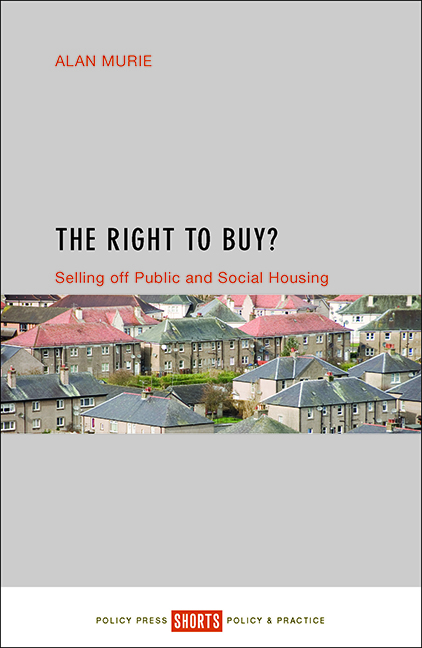Book contents
- Frontmatter
- Contents
- List of tables and figures
- About the author
- Acknowledgements
- 1 Introduction
- 2 Selling public housing: precursors and preconditions
- 3 A policy history of the Right to Buy, 1980-2015
- 4 Statistics and impacts of the Right to Buy
- 5 A policy commentary
- 6 The next phase: extending the Right to Buy in England
- 7 Conclusions: public and social housing: slow death or new beginnings?
- References
- Index
3 - A policy history of the Right to Buy, 1980-2015
Published online by Cambridge University Press: 05 April 2022
- Frontmatter
- Contents
- List of tables and figures
- About the author
- Acknowledgements
- 1 Introduction
- 2 Selling public housing: precursors and preconditions
- 3 A policy history of the Right to Buy, 1980-2015
- 4 Statistics and impacts of the Right to Buy
- 5 A policy commentary
- 6 The next phase: extending the Right to Buy in England
- 7 Conclusions: public and social housing: slow death or new beginnings?
- References
- Index
Summary
Introduction
The Right to Buy, providing most council tenants with the right to purchase the house they lived in, was to become the most significant privatisation of all those introduced by the Thatcher government. The Right to Buy was regarded by the government as having been a vote winner, and was introduced as part of a package of policies that broke the long established pattern of support for both council housing and home ownership. It was variously regarded as providing neo-Conservative (supporting the family and promoting stability) or neoliberal (increasing reliance on markets) alternatives to the mixed economy of welfare that had operated in the housing sector. It brought the era of management of a housing system with substantial collective ownership to an end – replaced by a market-based deregulated system of housing finance and private renting and subsidised home ownership.
This book argues that the Right to Buy and the wider housing policy package was an experiment in the sense that it sufficiently broke policy continuity, and that its impact was uncertain. There were beliefs that, if councils reduced their housing activity, private actors would flourish and fill the gap, and increasing home ownership would improve decisions about what was built, maintenance and repair and use of the housing stock. But there was no hard evidence to support these beliefs. Indeed, the failure of the market to provide enough appropriate housing, when and where it was needed, partly explained why council housing had developed such a significant role in the UK. There was a real risk that dismantling collective provision would reduce supply and standards and widen housing inequality.
The Right to Buy was also an experiment in privatisation. If housing privatisation had followed the pattern of other privatisations it might have been expected that public housing would have been parcelled up into portfolios of property to be owned and managed by private companies with shares in these companies being sold. Regional or local housing companies might have emerged, as did water companies. But previous proposals for the sale of council houses had accumulated commitments to sitting tenants, and the policy built on the popularity of home ownership. Consequently, only the sitting tenant was given the Right to Buy, and then only to become an owner-occupier.
- Type
- Chapter
- Information
- The Right to Buy?Selling off Public and Social Housing, pp. 31 - 64Publisher: Bristol University PressPrint publication year: 2016



